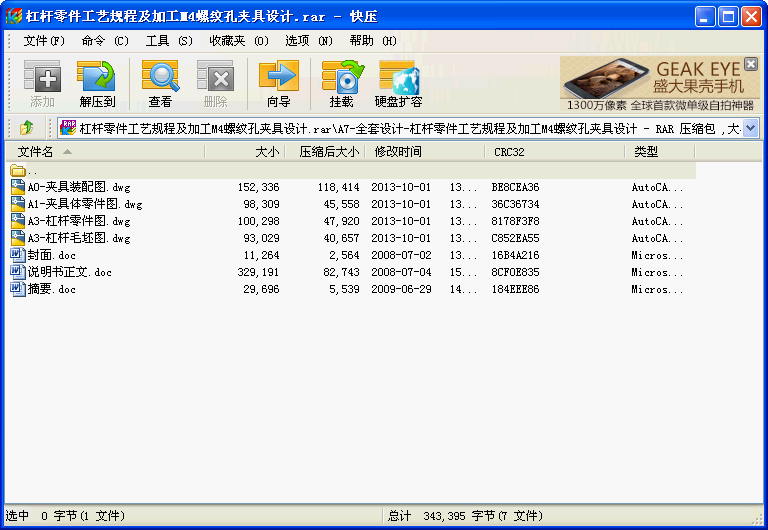杠桿零件工藝規(guī)程及加工M4螺紋孔夾具設(shè)計
- 文件介紹:
- 該文件為 rar 格式(源文件可編輯),下載需要
20 積分
-


- 杠桿零件工藝規(guī)程及加工M4螺紋孔夾具設(shè)計
摘 要
機械制造課程設(shè)計的主要內(nèi)容是夾具的設(shè)計,是在我們完成了全部的基礎(chǔ)課等課程之后進行的。這是對于之前所學(xué)的各課程的一次深入的綜合性的復(fù)習(xí),也是一次理論聯(lián)系實際的訓(xùn)練,因此,它在我們四年的大學(xué)的學(xué)習(xí)中占有重要的地位。
通過本次的課程設(shè)計,我們應(yīng)該得到以下各方面的鍛煉:
1、能夠熟練運用機械制造課程設(shè)計中的基本理論以及在實際設(shè)計中學(xué)到的實踐知識,正確地解決一個零件在加工中的定位、夾緊以及工藝路線安排、工藝尺寸確定等問題,保證零件加工質(zhì)量。
2、提高結(jié)構(gòu)設(shè)計的能力。通過設(shè)計夾具的練習(xí),應(yīng)該獲得根據(jù)被加工零件的加工要求,設(shè)計出高效、省力、經(jīng)濟合理而且能保證加工質(zhì)量的夾具的能力。
3、學(xué)會使用各種手冊及相關(guān)資料、查閱相關(guān)圖表。掌握與本設(shè)計有關(guān)的各種資料的名稱、出處、能夠做到熟練的運用。
關(guān)鍵詞:機械制造,地位,定位,工藝路線,鍛煉
Abstract
Machinery Manufacturing design courses are the main contents of the fixture design,We are in complete all the basic courses and other courses conducted by.This is the school before the various courses of an in-depth comprehensive review of the,Is also a theory with practical training,so,It in our four years of university study, occupy an important position.
Through this curriculum design, we should be following all aspects of training:
1、Skilled use of machinery to design courses in basic theory and practical design schools to the practice of knowledge, the right solution to a part in the processing of positioning, clamping and arrangements of line, identify the issues of size, quality assurance parts processing.
2、Improve the structural design capacity. Through the design of the fixture to practice, should be processed in accordance with the requirements of the processing components, design efficient, effort, economic and reasonable to ensure the quality of the processing capacity of the fixture.
3、Learn to use manuals and related information, access to the relevant charts. The design and master all kinds of information relating to the name, origin, can do skilled use.
Key words: Machinery Manufacturing, status, location, the process line, training
目錄
1.零件圖分析 1
1.1零件的功用 1
1.2零件的技術(shù)要求 1
1.3審查杠桿的工藝性 2
1.4確定杠桿的生產(chǎn)類型 2
2.確定毛坯、確定毛坯尺寸、設(shè)計毛坯圖 2
2.1確定毛坯制造方法 2
2.2確定毛坯尺寸公差和加工余量 2
2.2.1確定毛坯尺寸 2
2.2.2確定毛坯尺寸公差等級和公差 3
2.3繪制毛坯圖 4
3.制定零件工藝路線 4
3.1選擇定位基準 4
3.1.1精基準的選擇 4
3.1.2粗基準的選擇 4
3.2表面加工方法的確定 5
3.3加工階段的劃分 6
3.4工序集中與分散 6
3.5工序順序的安排 7
3.5.1機械加工工序的安排 7
3.5.2熱處理工序及表面處理工序的安排 8
3.5.3輔助工序安排 8
3.6確定工藝路線 8
4.工序設(shè)計(加工M4螺孔) 9
4.1確定加工方案 9
4.2確定加工余量 9
4.3計算兩次工序尺寸的基本尺寸 10
4.4兩次工步計算 10
4.4.1鉆孔工步 10
4.4.2攻絲孔工步 10
5.時間定額的計算 11
5.1兩工步時間定額的計算 11
5.1.1鉆孔工步 11
5.1.2絲攻工步 11
5.2輔助時間的計算 11
6.夾具設(shè)計 11
6.1問題的提出 12
6.2.1定位方案設(shè)計 12
6.2.2上述方案的比較 12
6.2.3夾緊力方向的選擇 12
6.2.4夾緊力作用點的選擇 13
6.2.5切削力及夾緊力計算 13
6.2.6夾具操作簡要說明 13
7.體會與展望 13
參考文獻 15
附錄1 17
附錄2 18
...
 看不清楚,換一個
看不清楚,換一個